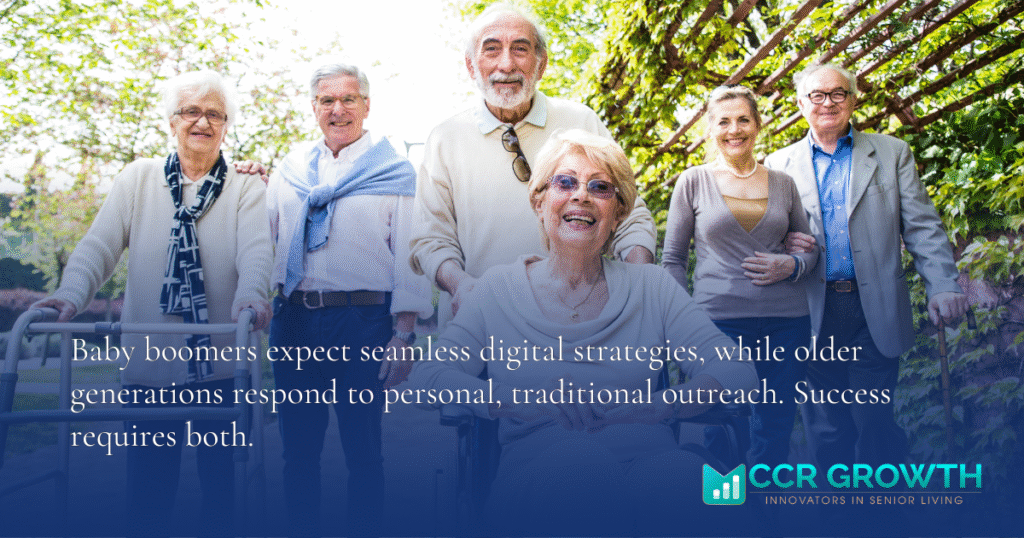
CCR Growth
A Complete Guide on How to Market to Seniors
Marketing to seniors is not the same as marketing to their adult children or loved ones who often influence decisions. The senior demographic makes up one of the fastest-growing and most influential age groups in the United States. Many seniors today are not only living longer but also enjoying more financial stability, greater disposable income, and an active lifestyle compared to previous generations. That combination creates a unique opportunity for providers, brands, and senior living operators that know how to market to seniors effectively.
At CCR Growth, we work with senior living operators every day to build marketing campaigns that resonate with older audiences. Whether you are targeting seniors directly or guiding their family members through complex decision making, the right marketing strategy ensures that your community stands out in a crowded marketplace.

Outline
Published on
10/15/2025
Key Takeaways
- Marketing to seniors requires balancing trust with family engagement, since decision making often involves both.
- Baby boomers expect digital convenience while older generations prefer traditional outreach, making adaptability essential.
- Consistency across marketing channels builds credibility and helps seniors feel confident in their choices.
- Campaigns perform best when they highlight safety and quality of life rather than focusing only on features.
- Personal touches such as phone calls, real stories, and approachable education create stronger connections than generic ads.
Why Your Marketing Strategy Must Adapt
When developing a marketing strategy for the senior market, you need to recognize that this age group does not behave like younger generations. While younger consumers may respond to fleeting trends or influencer campaigns, older consumers value straightforward messaging, personal touch, and clarity in marketing materials.
The senior demographic also represents specific demographics within it. You are not speaking to a single uniform group, but rather to older adults with different life experiences, expectations, and levels of comfort with technology. That requires multi channel marketing efforts that combine modern tools such as digital marketing strategy and email marketing with trusted approaches like direct mail and phone calls.
Most importantly, older adults and their family members often approach decision making with caution. They want marketing messages that are visually appealing, user friendly, and trustworthy. When your marketing efforts provide that, you create a clear advantage in reaching potential clients.
Understanding Baby Boomers and Other Generations
The baby boomer generation, now reaching retirement age in large numbers, plays a crucial role in shaping the senior market. Unlike previous generations, baby boomers are digitally savvy and often own multiple mobile devices. They shop online, engage with video content, and expect businesses to provide a digital marketing strategy that feels seamless.
At the same time, many older adults outside of the baby boomers still prefer more traditional marketing channels. Older demographics may not spend money online as comfortably as their younger counterparts, but they are responsive to marketing campaigns that feel personal. Recognizing these differences across older generations helps you effectively reach your target audience.

Disposable Income and Spending Power
One reason the senior market is so important is that older customers often have enough money to support a lifestyle that includes private care, senior living, or specialty products and services. Seniors hold significant spending power, and many marketers underestimate how much older adults are willing to invest when they trust a brand.
This is particularly true in the context of senior living, where family members are often involved in the process. Marketing messages must present communities in a positive light, showing how older adults can stay active, receive compassionate care, and enjoy their independence. Successful marketing requires you to frame offerings as an investment in quality of life, not simply a purchase.
Marketing Campaigns That Resonate with Older Adults
If you want to engage seniors, your marketing campaigns must balance clarity with warmth. Many marketers make the mistake of talking down to older audiences, but older consumers want straightforward messaging presented in a respectful and positive light. That means using action oriented language, telling real life success stories, and demonstrating the benefits of your service in ways that feel authentic.
For example, video content can be a powerful tool to encourage older adults and their families. Showcasing real life success stories of residents who have found purpose and connection in senior living communities helps prospective clients envision themselves making the same choice. Coupled with supportive marketing materials that are visually appealing and easy to navigate, your campaign stands out.
Direct Mail and Phone Calls Still Matter
Even in a world dominated by digital marketing, direct mail continues to play a crucial role in targeting seniors. Many older adults appreciate the tangible nature of brochures, postcards, and newsletters. These marketing materials allow them to spend time reviewing information and discussing it with family members.
Phone calls also remain effective when handled with care. While younger counterparts may ignore calls, older consumers are more likely to appreciate personal outreach. Calling potential clients or family members provides the personal touch that demonstrates commitment. Just that simple effort can set you apart from other platforms that rely solely on automated digital marketing.
Multi Channel Marketing for the Senior Audience
The most successful marketing campaigns for the senior demographic combine digital and traditional approaches. Multi channel marketing ensures that you can engage seniors wherever they are most comfortable. A digital marketing strategy may include email marketing, online shopping experiences, search engine results optimization, and video content across various channels.
At the same time, marketing to older adults should incorporate proven approaches such as direct mail, print ads, and community events. These other platforms support your digital presence and create multiple opportunities for older demographics to connect with your brand. This is how you effectively reach different demographics within the senior audience.
Marketing Channels That Work for Seniors
When selecting marketing channels, consider how your target demographic consumes information. Many older adults are increasingly tech savvy and spend time on social media, reading online reviews, or exploring user friendly websites. Others, especially those in older demographics, may be more comfortable with marketing efforts that rely on phone calls, brochures, or in-person presentations.
A balanced mix of marketing channels allows you to engage seniors on multiple levels. For example, video content shared via email marketing and supported by direct mail creates consistency. That consistency builds trust, which is essential when marketing to seniors making life decisions that involve family members and financial planning.
The Role of Disease Control and Education in Marketing to Seniors
When marketing to seniors in healthcare or senior living, issues like disease control, safety, and health education must be part of the conversation. Straightforward messaging that explains how your community prioritizes safety provides reassurance to potential clients.
Older audiences also value clarity when it comes to healthcare policies, social security, and financial realities. Marketing messages that include accessible education about these topics demonstrate your understanding of senior citizens’ unique concerns. Positioning yourself as a trusted advisor is one of the most effective ways to build relationships in the senior market.
Email Marketing and Digital Tools that Encourage Older Adults
Email marketing continues to be one of the most powerful tools for engaging older adults. While younger generations may see email as outdated, many seniors rely on it as a primary communication method. Effective campaigns must be user friendly, visually appealing, feature action oriented language, and provide straightforward messaging that guides seniors toward taking the next step.
Digital marketing also plays a crucial role in reaching digitally savvy baby boomers. From mobile devices to online shopping platforms, older consumers are comfortable interacting with well-designed websites and digital marketing campaigns. Your job is to make sure these experiences are seamless, visually appealing, and provide clear pathways for decision making.
Action Oriented Language and Personal Touch
Successful marketing to older adults requires both clarity and connection. Action oriented language encourages seniors to take the next step, while a personal touch reassures them that they are making the right choice. Whether your marketing materials appear in search engine results, direct mail, video content, or email marketing, every message must reflect authenticity.
When you engage older audiences with respect, deliver straightforward messaging, and leverage real life success stories, you build confidence in your brand. That confidence drives decision making, especially when family members are part of the process.
Marketing to Seniors with CCR Growth
Marketing to seniors is about more than running ads. It requires a thoughtful marketing strategy that balances digital tools, traditional marketing channels, and personal connection. The senior demographic represents significant spending power, diverse preferences, unique needs, and strong family involvement in decision making. To effectively reach them, your marketing campaigns must combine straightforward messaging, multi channel marketing, and a focus on building trust.
At CCR Growth, we help senior living operators create successful marketing systems that not only generate leads but also convert them into lasting relationships. If you are ready to engage older adults more effectively and grow your community, reach out to CCR Growth today. Together, we will build a marketing strategy that positions your organization as the trusted choice for older adults and their families.
Subscribe to our newsletter
Sharpen your expertise and stay ahead of senior living industry trends—subscribe to CCR Growth’s newsletter for exclusive insights and updates.
Recent Posts



A Complete Guide to Generative Engine Optimization for Senior Living
Redefining Senior Living Marketing, Sales, and Operations
CONTACT ADDRESS
8710 Carmel Valley Road, Carmel, CA 93923
GENERAL INQUIRIES
info@ccrgrowth.com
(831) 273-3628
SOCIAL MEDIA




